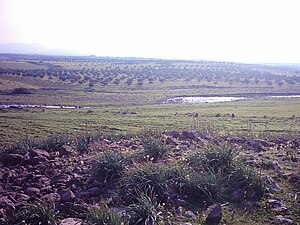The Houla Region or Houla Plain (Arabic: الحولة Al-Ḥūla) is an area consisting of three villages in the Homs Governorate of central Syria, northwest of the city of Homs. The biggest village in the Houla region had 20,041 inhabitants in 2004 and is called Kafr Laha.[1] The second largest village, Taldou,[2] had 15,727 inhabitants in 2004 and is located in the outskirts of Houla.[3] The third village, Tell Dahab had 12,055 inhabitants in 2004. The settlement is essentially a Turkmen Sunni Muslim town, where Turkish language is widely spoken among its people. Houla is also surrounded by Alawite neighboring villages.[4] Many of the inhabitants of the Houla village cluster are of Turkmen descent.[5]

Houla was described by 19th-century English scholar Eli Smith as a low-lying tract of land situated at the eastern slope of the Syrian Coastal Mountain Range.[6] The 13th-century Syrian geographer Yaqut al-Hamawi visited al-Houla in 1226 during Ayyubid rule noting that the place belonged to Jund Hims ("military district of Homs").[7]
- ^ "2004 General Census". Central Bureau of Statistics. Archived from the original on 2012-07-29. Retrieved 2012-05-27.
- ^ "Shelling of Houla area in Syria reportedly kills at least 90". Los Angeles Times. 26 May 2012. Retrieved 26 May 2012.
- ^ "Anger In Syria After Ceasefire 'Massacre'". Sky News. May 26, 2012. Archived from the original on May 28, 2012. Retrieved May 26, 2012.
- ^ Lyons, John (June 1, 2012). "Syria's deadly dynasty". The Australian. Retrieved June 9, 2012.
- ^ Hartmann, 2012, p. 54.
- ^ Smith, 1841, p. 179.
- ^ le Strange, Guy (1890). Palestine Under the Moslems. Palestine Exploration Fund. p. 455.
Haffah.